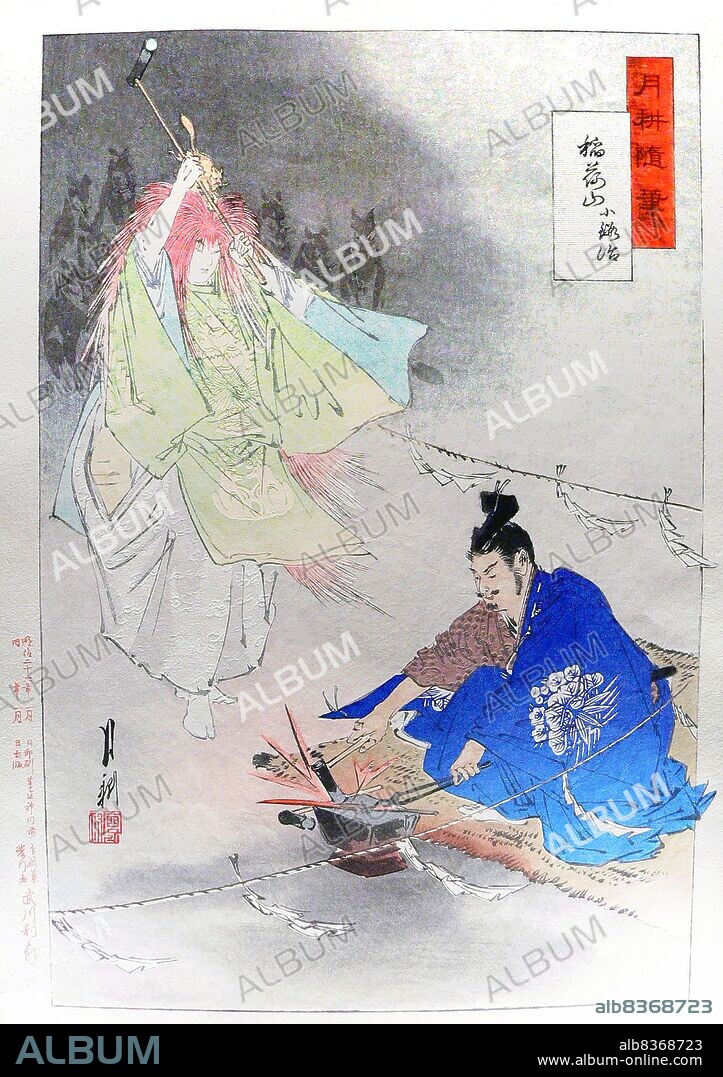alb8368723
Japan: 'Blacksmith Munechika, helped by a fox spirit, forging the blade Ko-Gitsune Maru< / i> (Little Fox) ', woodblock print by Ogata Gekko (1859-1920),1873

|
Ajouter à une autre Lightbox |
|
Ajouter à une autre Lightbox |



Avez-vous déjà un compte? S'identifier
Vous n'avez pas de compte ? S'inscrire
Acheter cette image

Titre:
Japan: 'Blacksmith Munechika, helped by a fox spirit, forging the blade Ko-Gitsune Maru< / i> (Little Fox) ', woodblock print by Ogata Gekko (1859-1920),1873
Légende:
Voir la traduction automatique
Inari Okami, also known as Oinari, is a deity in Shintoism, the kami of foxes, fertility, rice, tea, sake, agriculture, industry and general prosperity. In earlier times, Inari was also the patron of merchants and swordsmiths, and has been represented in various art forms as male, female or androgynous.
. Inari is almost always accompanied by white foxes (kistune), who act as his/her/their messengers. Inari's male and female aspects have often been conflated or identified with other Shinto and Buddhist deities, and Inari him/her/themself has sometimes been seen as a collective rather than an individual kami.
. Worship of Inari dates back to at least 711 CE, with a shrine on Inari Mountain, although some scholars date worship back to the late 5th century. The kami became more popular during the Edo Period (1603 - 1868). Today more than one-third of Shinto shrines in Japan are dedicated to Inari.
. Inari is almost always accompanied by white foxes (kistune), who act as his/her/their messengers. Inari's male and female aspects have often been conflated or identified with other Shinto and Buddhist deities, and Inari him/her/themself has sometimes been seen as a collective rather than an individual kami.
. Worship of Inari dates back to at least 711 CE, with a shrine on Inari Mountain, although some scholars date worship back to the late 5th century. The kami became more popular during the Edo Period (1603 - 1868). Today more than one-third of Shinto shrines in Japan are dedicated to Inari.
Crédit:
Album / Universal Images Group / Pictures From History
Autorisations:
Modèle: Non - Propriété: Non
Questions sur les droits?
Questions sur les droits?
Taille de l'image:
3600 x 5097 px | 52.5 MB
Taille d'impression:
30.5 x 43.2 cm | 12.0 x 17.0 in (300 dpi)
Mots clés:
10E SIECLE • 10EME S • ART (CATÉGORIE) • ART • ART, PEINTURE • ASIE • ASIE, CONTINENT • CLOUTIER • COMMERCE FORGERON • CONTINENT ASIE • DEESSE • DIEU • DIEUX • DIVINITÉ • DIXIÈME SIÈCLE • EPEE • FORGERON • GEKKO, OGATA • KAMIS • METIER: FORGERON • MYTHOLOGIE • OGATA GEKKO • PEINTURE • PROFESSION FORGERON • RELIGION • SHINTÔ • SHINTOISME • TABLEAU • TABLEAUX • XE SIECLE
 Pinterest
Pinterest Twitter
Twitter Facebook
Facebook Copier le lien
Copier le lien Email
Email
